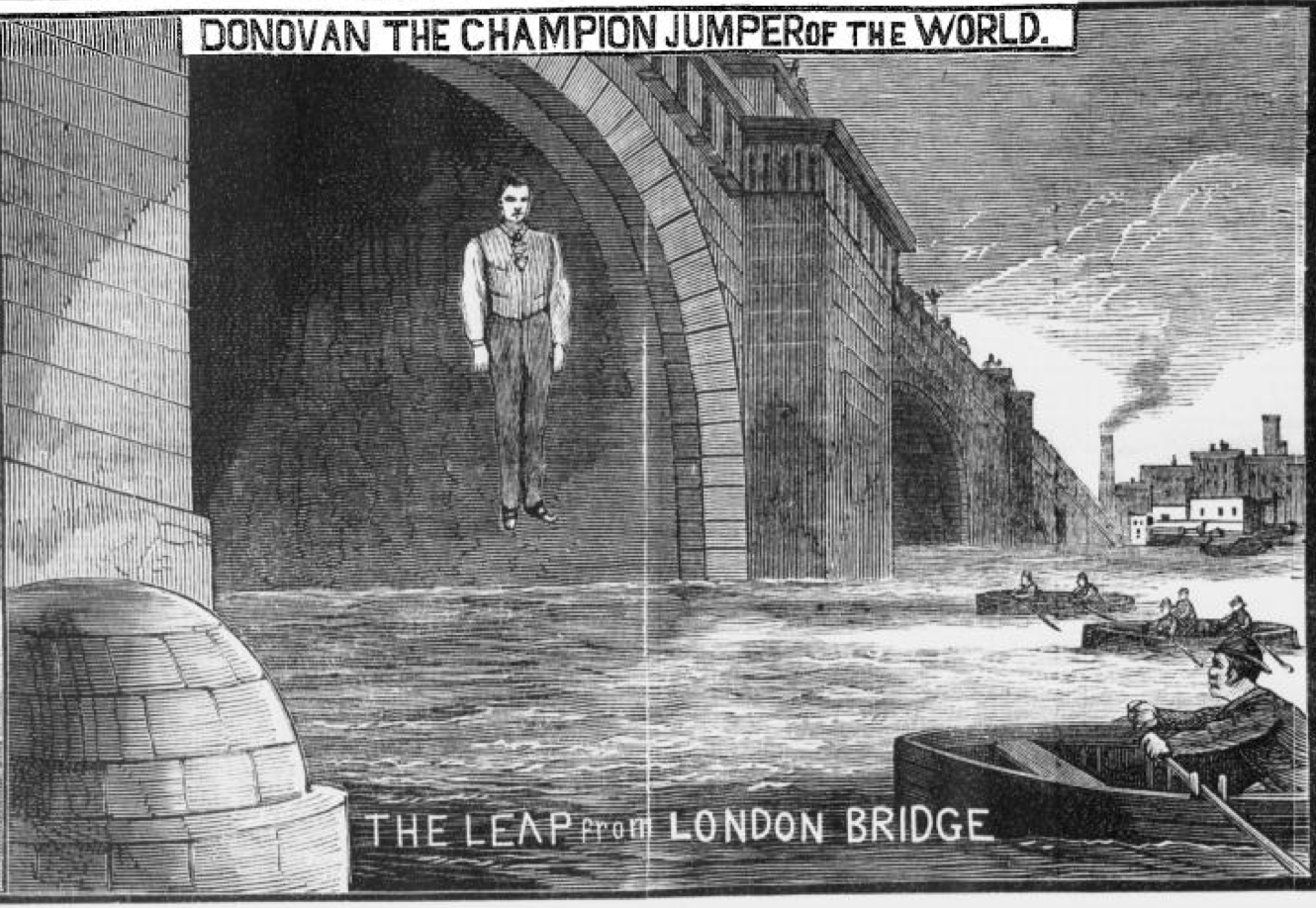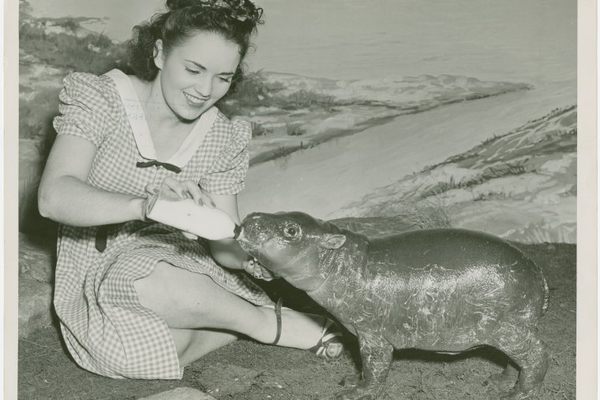Larry Donovan, 1880s Bridge Jumper, Lived Too Soon
Just imagine what would have happened to this man in the age of YouTube.

Before he became known as one of the world’s most prolific bridge jumpers and quite possibly the first ever viral celebrity, Lawrence “Larry” Donovan had already lived many lives. Apart from a brief time away during a stint in the U.S. Army, as a young man Donovan worked as a printer and typesetter for a number of publications in New York City. He also dabbled in poetry.
When he returned from his service in 1882, Donovan started working at the New York Police Gazette. The publication was a sort of Maxim for 19th century-New York, covering topics such as crime and sports alongside racy images of scantily clad women. It was during his years there that Donovan would develop his taste for jumping off bridges, thanks in part to the support of the Gazette’s editor, Richard K. Fox. As an editor, Fox had an eye for feats and record-breaking, often offering rewards to those who could perform them. One site devoted to the history of the Gazette likens Fox to Howard Stern.
By the mid-1880s, a dangerous game of one-upmanship had begun in New York, as a succession of people attempted to be the first to jump off of the newly completed Brooklyn Bridge. The first person to attempt the feat was the swimming instructor Robert Emmet Odlum, in May of 1885. He died shortly after being pulled from the water. The next person to attempt the jump, in 1886, was Steve Brodie, a gambler and race walker looking to make a name for himself. There’s some dispute as to whether he actually made the jump, but the fact that he survived garnered him enough fame that he was able to open his own saloon. His last name even became shorthand for anyone attempting something foolhardy, as in, “to pull a Brodie.” It was in the shadow of these previous attempts that Donovan first decided to try his hand at bridge jumping.

According to an interview with Donovan in the Te Aroha News in February 1888, Donovan had never had any interest in jumping off of bridges prior to Brodie’s attempt:
We do not read, even in the imaginative newspapers, of his own country of the newly short-coated Donovan climbing onto the back of a chair whist his nurse’s back was turned, and from that dizzy eminence precipitating himself into the abyss of the footbath. […] But if any juvenile experiences befell him, no particulars of them have been preserved, and the champion jumper himself has no anecdotes to tell of juvenile trials and triumphs, or of the ups and downs of infancy.
Early in the morning of August 28, 1886, Donovan made the plunge from the Brooklyn Bridge, jumping from a point 29 feet higher than where Brodie claimed to have jumped from, according to The New York Times. He wore weighted shoes to help keep himself upright as he fell, and padded leggings to protect himself on impact. As an added bit of flare, he also put on a black derby hat.
Donovan made the jump successfully, and two rescue boats filled with friends and members of the Gazette staff picked him up when he surfaced, supposedly also collecting his hat along the way. The only injury he reported was a slight stomach pain.
Since the stunt was unauthorized, police promptly scooped up Donovan. The judge charged him with disorderly conduct and fined him $10 for obstructing traffic on the bridge. Fox paid the fine.
The Gazette published a glowing article the next month titled “A Dizzy Leap,” declaring Donovan the “champion bridge jumper of the world.” The paper sang Donovan’s praises, touting him as the Gazette’s home-grown hero. Other news outlets soon picked up on the story, with The Times dubbing him “Crank No. 3.” In that same Times piece, Donovan was also said to have made $200 off of friendly bets, although according to an 1888 article in The Manning Times of South Carolina, he placed a $500 bet with an unknown party, thought to be Fox. Whether the idea to jump from the bridge was his own, or was spurred on by Fox to create a story for the Gazette, Donovan had caught the fame bug, and bridge-jumping was now his thing.

By all accounts, Donovan wanted to continue capitalizing on his newfound fame, and he soon made an abortive attempt to stage a jump into the Genesee River in Rochester, New York, but was arrested before he could pull off the stunt. No sooner was he released than he headed to Niagara Falls, planning his next leap off of the now-defunct Niagara Falls Suspension Bridge. On the morning of November 7, 1886, Donovan performed a successful bridge jump off of the Niagara bridge, falling an impressive 190 feet into the waters below. Again, he wore his derby hat.
In a post-jump interview with the Times, Donovan claimed he hadn’t made a cent from the Niagara jump, saying that he had instead done it “out of respect to the newspapers of the United States which have treated me handsomely since my Brooklyn Bridge jump.” His injuries included a broken a rib and bruised a lung. The New York Clipper would call him the “Aerial Hero of Niagara.”
In February 1887, Donovan leapt off of the Chestnut Street Bridge over Philadelphia’s Schuylkill River. Once again, he injured his chest in the fall, but survived. By now, the media attention had started to wane. It’s unclear whether Donovan made any money off of his third daredevil act.
Donovan returned to New York, where he made appearances at dime museums to get by. In April of 1887, he announced that he was going to dive off the Brooklyn Bridge again, but this time, head first. Worried, his mother, who had been in attendance during his first jump off the Brooklyn Bridge, informed the police of her son’s plans. As officers pulled Donovan from the carriage that had taken him to the bridge, he claimed to have just met the driver, and that it was all an innocent misunderstanding.
This time, the judge threw Donovan in jail for some three months. According to an April 1887 piece in the Bridgeport Morning News, Brodie visited Donovan in jail to bring him cigars and tobacco.

The judge also made him promise never to jump off of a New York bridge again. After he was released, Donovan decided that maybe the audiences in America had seen too much of his act, and he headed to England. Arriving on June 1, 1887, Donovan announced his arrival in the country by jumping off the London Bridge on June 5. But the response was tepid. As it was described in an 1888 edition of The Referee, “his feats found but little favour, and were only looked upon as a species of foolhardiness.”
Undeterred, Donovan made plans for a leap from Bristol’s Clifton Suspension Bridge, to honor the Golden Jubilee of Queen Victoria. He later claimed that he’d expected to meet the queen after successfully completing the stunt. But before he could make his devotional leap, Donovan was once again arrested on the bridge and given jail time for attempted suicide.
He stayed in England after his release, at one point jumping off of the small Waterloo Bridge dressed as a comic strip character for a promotional event. In March of 1888, he supposedly made a second, successful attempt to jump from the Clifton Bridge, but accounts, even at the time, differ, and it is unclear to this day whether he actually made the jump.

His path to fame having run aground, Donovan struggled for months, and by August of 1888, he’d bottomed out. On August 7 of that year, Donovan made his last bridge jump, this time off of the Hungerford Bridge over the Thames. Broke and down on his luck, he’d gone out drinking the night before with some friends he’d met at the public house where he was staying. According to an account in the New Zealand Herald, they’d teased him about his Clifton Bridge jumps until he accepted a measly £2 bet to perform an impromptu jump from the Hungerford Bridge. Whether out of pride, poverty, or sheer drunkenness, Donovan accepted, and drowned in the attempt. The Times reported that the fall was 100 feet down.
Fox, who’d had a large hand in starting Donovan down his doomed path toward notoriety, died in 1922, and is remembered for popularizing boxing and sports journalism. Donovan is mainly remembered as the man who followed Brodie’s famous leap, or by those who stumble upon his well-researched Wiki. More than 100 years on, Donovan’s tale of fleeting, foolish stardom echoes the all-too-common rise and fall of today’s constant stream of viral Internet stars, unprepared for fame. Hopefully it doesn’t kill them too.












Follow us on Twitter to get the latest on the world's hidden wonders.
Like us on Facebook to get the latest on the world's hidden wonders.
Follow us on Twitter Like us on Facebook